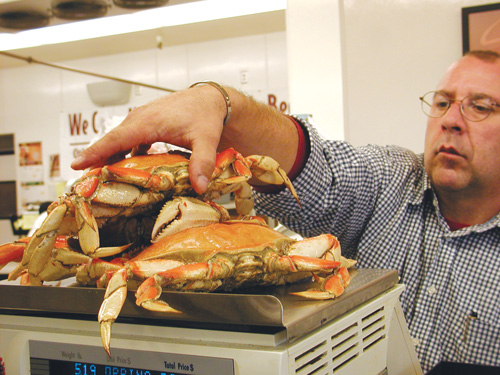
Stores expect to have local crab soon
Locally caught crab has long been Northern California tradition and locals say it can be a healthy, easy, tasty and a fun addition to the Thanksgiving menu.
“It’s nice to have an easy meal to do before the big preparation for the following day,” said Mitch Castleberry, meat department manager at Big John’s Market. “There’s no doubt it is a tradition around the San Francisco area,” he said.
He said the store sells tons of crab over the course of the season, but they see a spike in demand before Thanksgiving with most customers requesting whole crab. “Nine out of ten are just getting whole cracked and cleaned crab,” he said.
The other 10 percent are looking for crab to incorporate into more complicated dishes and Castleberry said the customers often purchase an assortment of seafood to accompany the store’s house made Cioppino sauce.
Commercial crab season begins on November 15, but it may take several days before crab appears in local stores due to negotiations between fishermen and wholesalers. Eager crab enthusiasts can get their fix before November 15 if they own the equipment to fish for themselves or join a group excursion.
Rick Powers owner of Bodega Bay Sportfishing and captain of the New Sea Angler said families looking for a holiday activity can turn a crab dinner into a day on the ocean and still return with everything they need for a great meal.
“They boil and eat it fresh, crab omelets, crab cakes, cioppino, do all those things that people enjoy doing,” he said of a day’s catch. “They can get six crabs for one person, plus a limit of rock fish, they’ve got half of cioppino right there.”
According to Powers, catching local crab has become a popular event for fishermen.
“Most people fished for cod, salmon, maybe tuna, but every recreational angler went to the store and bought their crab,” he said. “Then sportsmen realized that it wasn’t that difficult to catch and harvest them on their own.”
He said fishermen with boats now look forward to the season. “The busiest sport fishing day of the year happens on the day that the Dungeness crab season opens every year,” he said.
Powers said a thanksgiving crab trip starts with a great day on the ocean, includes a great meal and a creates a set of memories, even for inexperienced fishermen. “It turns into multiple days, not just one day of fun. A lot of people don’t know that an outing of this nature exists,” he said. “They’re intimidated, they don’t have a license or rod but they don’t need any of that. You can purchase a license online, rent a rod and reel from us.”
According to the Department of Fish and Game, the most popular methods for crab fishing are with pots, traps, and nets but some eager fishermen dive right in to try hand fishing.
DFG said Dungeness crabs prefer cooler northern and central California waters and are uncommon south of Point Conception. They are usually found on sandy or sand-mud bottoms at depths of less than 300 feet, although they can be found in almost any sea floor habitat, and have been documented down to 750 feet.
There is no limit to the number of pots or nets that can be fished recreationally, except when fishing from a public fishing pier where only two fishing appliances may be used.
Government officials said recreational crabbers may keep up to ten Dungeness crabs per day, or six crabs if fishing from a party boat south of Mendocino County. No one may possess more than one daily bag limit, and no Dungeness crab may be taken from San Francisco or San Pablo bays, which are important crab nursery areas.
The recreational size limit for Dungeness crab is five and three-quarter inches measured across the shell, directly in front of and excluding the lateral spines. Crab taken from party boats south of Mendocino County must measure at least six inches across.
In order to protect undersized crab and other species that may be accidentally caught, crabbers are required to raise nets to the surface for inspection every two hours. Fishermen using traps are also encouraged to make regular inspections of their equipment to prevent lost gear from becoming an ocean hazard.
Powers said sport fishermen have had good yields so far. “We’ve caught full limits for every person that’s stepped on my boat. We’re batting a thousand and not missed yet. The quality is as good as it gets.”
Officials from the Department of Fish and Game said their preliminary testing suggests it will be a good year for crab but that yields may be down from recent highs.
“Crab populations appear to be strong coming off another record-setting year in the commercial fishery,” said Department of Fish and Game (DFG) Senior Environmental Scientist Pete Kalvass, who oversees the Invertebrate Management Project. “However, crab in northern California above Cape Mendocino may be somewhat underweight for the first few weeks of the season due to a late molt.”
Kalvass said last year’s commercial crab fishing season brought in 32 million pounds of crab, with about 16 million pounds coming from the Sonoma County region. He said sport fishing brought in about half a million pounds in the 10-11 season and he said given the huge numbers over the last two years, it’s likely that the 2012 season my decline slightly. “(Last year) was a record year so it’s not going out on a limb to say that it’s going to be a little lower,” he said. “The indication is there is still a good abundance but it won’t be as high as last year and it’s a very cyclical fishery. In the 08-09 season they only landed 6 million. Three seasons later, we’re at 32 million so I expect that we’d start the down cycle.”
While quantity may be down slightly, quality is expected to be high. Kalvass said the industry standard for a quality crab is for 25 percent of the crab’s total weight to be meat and that during early testing in October, Bodega Bay crab were coming in at around 23 percent. “The fact that they’re growing daily by the time the sport fishing starts and commercial season opens on the 15th, the crab should be in good shape.”
For more information regarding recreational Dungeness crab fishing regulations and other crab species, visit the DFG Marine Region website at www.dfg.ca.gov/marine/invertebrate/crabs.asp.
Seafood Gumbo
1/2 cup diced celery
1 cup diced peppers
1.5 cup diced onion
2 cup diced ripe tomato, fresh or canned
2 tablespoons garlic, finely chopped
1 cup diced okra
1 pound shrimp (head on if making broth)
Meat of two whole, cooked crab
1 teaspoon fresh thyme, chopped
1 teaspoon paprika
1/4 teaspoon cayenne pepper
1/2 teaspoon red pepper flakes
1 tablespoon filé powder (can substitute creole seasoning)
1 tablespoon salt
1/2 teaspoon black pepper
2 ounces vegetable oil
2 ounces all purpose flour
1 quart broth (store bought lobster/shrimp broth or see recipe below)
If using head on shrimp: clean, peel and dehead shrimp. Reserve heads and shells for broth. Cover cleaned shrimp and put in refrigerator. Make broth (see below).
Set pot over medium heat. Wisk flour and oil together making sure to remove any lumps. Cook until mixture is light brown. Add onion, peppers, celery, garlic, okra and cook for between 5 and 10 minutes stirring constantly or until onions are translucent. Add tomato, thyme, cayenne, red pepper, paprika, salt, pepper and stock. Bring to a boil then reduce heat and simmer for 25 minutes. Add shrimp and crab. Stir gently to combine. Remove from heat and add seasoning/filé powder. Serve over white rice.
Broth
1 bay leaf,
3 basil leaves
1 clove garlic, pealed
2 quarts water
Shrimp heads and shells
salt and pepper to taste
Combine all ingredients and bring to a boil. Reduce to simmer and cook until liquid has reduced by half.







